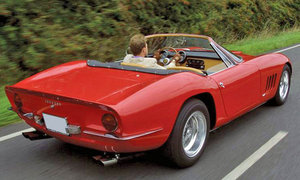Difference between revisions of "Nembo"
m |
m |
||
| Line 11: | Line 11: | ||
The tradition of custom [[Coachbuilders|coachbuilding]] or [[carrozzeria]] died in the 1960s as new technology made “[[frames]]” obsolete. [[Ferrari]] and [[Alfa Romeo]] were among the last [[constructors]] still building automobiles with separate frames, and this accounted for the pre-eminence of [[Italian]] [[Coachbuilders|coachbuilders]]. The [[carrozzeria]] prospered, supported by sporting chassis and powerful drivetrains and nurtured by the [[Italian]] passion for design. Such supremacy drew the best talent from Italy and around the world. Californian Tom Meade went to Italy to realize in metal the shapes in his mind. | The tradition of custom [[Coachbuilders|coachbuilding]] or [[carrozzeria]] died in the 1960s as new technology made “[[frames]]” obsolete. [[Ferrari]] and [[Alfa Romeo]] were among the last [[constructors]] still building automobiles with separate frames, and this accounted for the pre-eminence of [[Italian]] [[Coachbuilders|coachbuilders]]. The [[carrozzeria]] prospered, supported by sporting chassis and powerful drivetrains and nurtured by the [[Italian]] passion for design. Such supremacy drew the best talent from Italy and around the world. Californian Tom Meade went to Italy to realize in metal the shapes in his mind. | ||
| − | Meade penned a series of cars, both mainstream and extreme, and temporarily became a leader in the Italian community of automobile stylists. In 1964 Meade made a series of three similar designs, echoing the elements of the 1964 GTO. Executing Meade’s concepts was the establishment of Srs. [[Giorgio Neri]] and [[Luciano Bonacini]], mechanical specialists serving the Ferrari market. The three [[Ferrari 250 GT]]s were called Nembo, a neat contraction of [[Neri & Bonacini]] and the name of an Italian cartoon character with Superman-like powers. S/N 1777 GT was built for Italian [[Sergio Braidi]]. | + | Meade penned a series of cars, both mainstream and extreme, and temporarily became a leader in the Italian community of automobile stylists. In 1964 Meade made a series of three similar designs, echoing the elements of the 1964 GTO. Executing Meade’s concepts was the establishment of Srs. [[Giorgio Neri]] and [[Luciano Bonacini]], mechanical specialists serving the Ferrari market. The three [[Ferrari 250 GT]]s were called ''Nembo'', a neat contraction of [[Neri & Bonacini]] and the name of an Italian cartoon character with Superman-like powers. S/N 1777 GT was built for Italian [[Sergio Braidi]]. |
The [[Nembo spyder]] is a wonderfully flamboyant motor car. The spyder design is perhaps best summed up by authorities Warren Fitzgerald and Richard Merritt in their definitive book Ferrari: The [[Sports cars|Sports]] and [[Gran Turismo]] Cars. They write: “The Neri & Bonacini spyder combines the best of [[Ferrari GTO|GTO]] and [[Ferrari 275|GTB]] lines...Neri & Bonacini is one of the most beautiful F[[errari]]s of all time and looks good from any angle.” [http://www.sportscarmarket.com/Profiles/2005/December/Ferrari/ <small>Source</small>] | The [[Nembo spyder]] is a wonderfully flamboyant motor car. The spyder design is perhaps best summed up by authorities Warren Fitzgerald and Richard Merritt in their definitive book Ferrari: The [[Sports cars|Sports]] and [[Gran Turismo]] Cars. They write: “The Neri & Bonacini spyder combines the best of [[Ferrari GTO|GTO]] and [[Ferrari 275|GTB]] lines...Neri & Bonacini is one of the most beautiful F[[errari]]s of all time and looks good from any angle.” [http://www.sportscarmarket.com/Profiles/2005/December/Ferrari/ <small>Source</small>] | ||
Revision as of 06:51, 23 July 2009
Nembo, short for Neri & Bonacini
The tradition of custom coachbuilding or carrozzeria died in the 1960s as new technology made “frames” obsolete. Ferrari and Alfa Romeo were among the last constructors still building automobiles with separate frames, and this accounted for the pre-eminence of Italian coachbuilders. The carrozzeria prospered, supported by sporting chassis and powerful drivetrains and nurtured by the Italian passion for design. Such supremacy drew the best talent from Italy and around the world. Californian Tom Meade went to Italy to realize in metal the shapes in his mind.
Meade penned a series of cars, both mainstream and extreme, and temporarily became a leader in the Italian community of automobile stylists. In 1964 Meade made a series of three similar designs, echoing the elements of the 1964 GTO. Executing Meade’s concepts was the establishment of Srs. Giorgio Neri and Luciano Bonacini, mechanical specialists serving the Ferrari market. The three Ferrari 250 GTs were called Nembo, a neat contraction of Neri & Bonacini and the name of an Italian cartoon character with Superman-like powers. S/N 1777 GT was built for Italian Sergio Braidi.
The Nembo spyder is a wonderfully flamboyant motor car. The spyder design is perhaps best summed up by authorities Warren Fitzgerald and Richard Merritt in their definitive book Ferrari: The Sports and Gran Turismo Cars. They write: “The Neri & Bonacini spyder combines the best of GTO and GTB lines...Neri & Bonacini is one of the most beautiful Ferraris of all time and looks good from any angle.” Source
| Car Information and Photos by Marque: A - B - C - D - E - F - G - H - I - J - K - L - M - N - O - P - Q - R - S - T - U - V - W - X - Y - Z |
| Motorcycle Information and Photos by Marque: A - B - C - D - E - F - G - H - I - J - K - L - M - N - O - P - Q - R - S - T - U - V - W - X - Y - Z |

